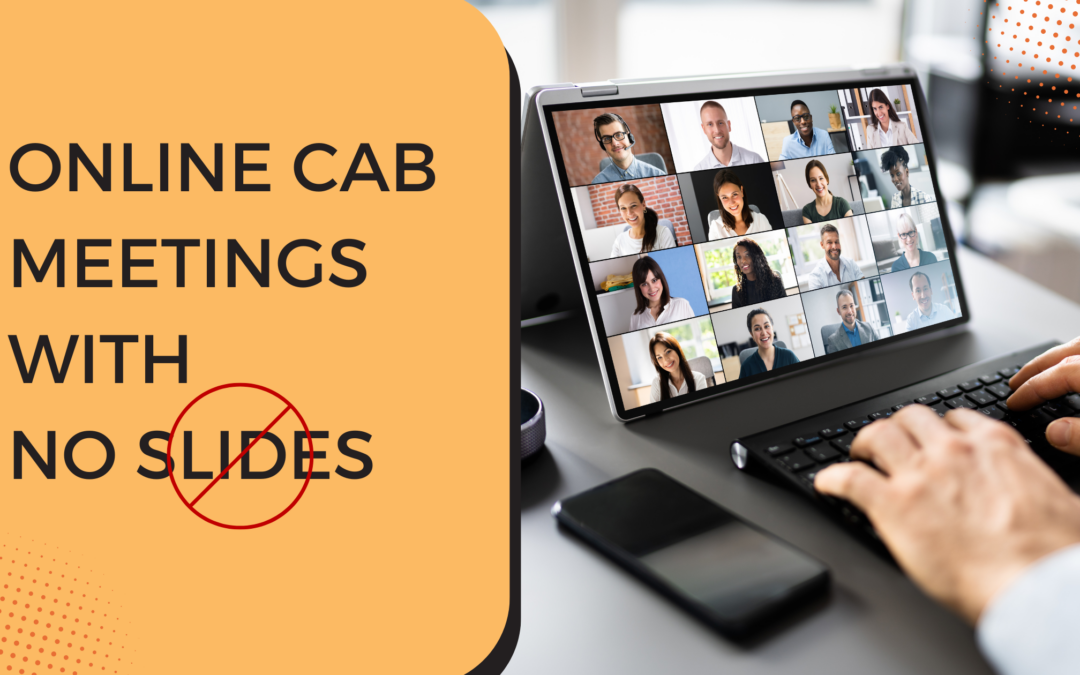In these days of ever-shrinking attention spans, less tolerance for sales messaging and overscheduled professionals, the era of long PowerPoint presentations may be coming to an end.
Indeed, PowerPoint is designed for one-way presentations to an audience (not unlike a class lecture). The medium is even worse for using at customer advisory boards (CABs). At a CAB, discussion, feedback and brainstorming new solutions and ideas is the desired outcome. I’ve written previously about how to avoid relying on PowerPoint slides in your in-person CABs meetings, and what to do instead.
But the concepts and suggestions also apply to CAB meetings held online via today’s popular meeting platforms, such as Zoom, Webex, GoTo Meeting, Teams, etc.
As such, here are five more strategies you can use instead of relying on boring slides, focused on online CAB member engagements:
1. Use the camera feature.
Seeing all participants on camera allows everyone to view and interact with each other. And you can read body language, especially excitement and the desire to contribute.
Using the camera will help deliver livelier discussions. It will get CAB members talking to each other instead of just with the host company or session owner.
As we all know the temptation to turn off cameras in meetings, set the expectation in advance with CAB members that you will be asking everyone to use them during the meeting. You will hopefully minimizing (ideally eliminating) non-camera participants.
2. Convey planned discussion questions.
CAB meeting session owners should always convey the purpose behind why they are covering a particular subject. They should share their session goals, what they are hoping to learn and the questions they are attempting to get answered.
Stating the discussion questions at the beginning of each session is important. Be sure to write them out (even on a slide). Even better, keep them visible throughout the session (e.g. on the group chat or Q&A function) so members will stay focused on the task at hand.
For even better results, embed the questions from each session on the agenda. Send the questions to CAB members in advance of the meeting. So they will have some time to consider them beforehand and bring their responses and ideas to the discussion.
3. Arrange for member spotlights.
CAB members always want to learn from each other in meetings. They want to benchmark their own operations compared to their peers. And they want to bring actionable insights back to their own companies to use right away.
As such, it’s helpful to use one or two real-world, actual customer operations, spotlights and case studies as examples of desired concepts. Here, your CAB members themselves will lead the discussion. They will provide insights to where they’ve succeeded (or failed), and offer lessons learned and advice for others to succeed within their own operations.
Such CAB member sessions are always very well received and reviewed by CAB member participants. This session helps drive to the 80:20 interaction (CAB members speaking 80% in meetings; host company only 20%) that is the goal of every CAB engagement.
4. Avail the agenda in the meeting invitation.
With the goal of keeping CAB members engaged throughout every session, review the meeting agenda at the beginning of the discussion. Make the agenda available in the meeting invitation for quick reference. This will allow members to take a peek at timelines to know the duration of each session and when the next break will be. They will know what topics are coming next and when the meeting will end.
Be sure to stick to the meeting agenda too – don’t delay breaks or greatly extend the length of your meeting, as CAB members may inevitably have other commitments to attend to following your meeting.
5. Encourage chat and Q&A participation.
While having about a dozen CAB member participants can generate lively discussion, sometimes the conversation is so quickly flowing that it can be difficult to hear everyone on a particular topic point.
As such, encourage your CAB members to use the chat and Q&A features of your meeting platform. This will provide another way for them to be heard, provide their perspectives and get their questions in front of the group.
An additional benefit here is that these items are usually captured by the meeting platform, and help with creating the post-meeting report. (Of course, utilizing the services of an experienced, professional meeting facilitator is the best way to ensure optimal member participation and meeting success.)
In Conclusion
While slides can be a helpful tool to communicate ideas, it should never be the sole medium used with CAB members. After all, you have invested the resources to gather your customers together – either in-person or online – with the goal of collecting their feedback, desires, ideas and suggestions.
Using the tactics above will not only help deliver that to your company but, more importantly, deliver a meeting experience your CAB members will benefit from and even enjoy.
Ignite Advisory Group is the leading global authority on Customer Advisory Boards and Customer-Led Boards. Ignite’s proven methodology for managing and evolving Customer Advisory Boards includes a 4-stage process, encompassing 48 deliverables and measured by 20 metrics to deliver a clear ROI. To learn more about Ignite, visit our website, read our blogs, and follow us on LinkedIn. To find out how your company can benefit from Ignite’s CAB methodology and process, contact us today.
